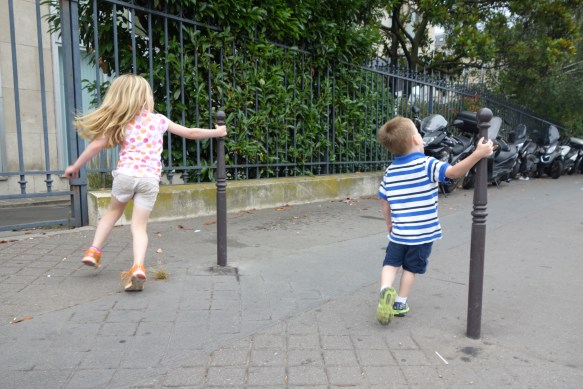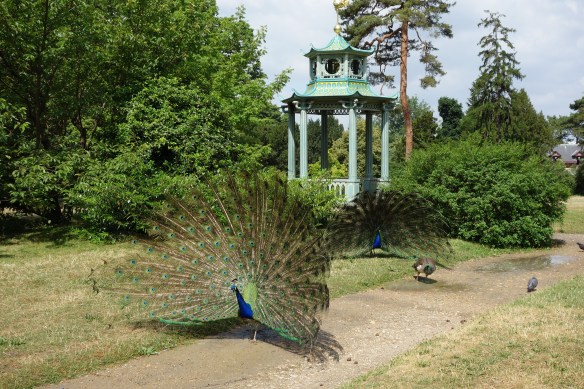This post is part of the Raising Multilingual Children Blogging Carnival. For other entries in this month’s carnival, check out Annabelle’s blog at the Piri Piri Lexicon.
I’m lucky to be raising my bilingual kids at a time when it’s “cool” to do so. Resources and research are easily found; information and advice on the subject are growing exponentially. Even seven, eight years ago, when I first started looking into raising children with two languages, I had a hard time finding resources.
The flip side of this is, of course, too much advice can leave one feeling overwhelmed and incompetent. Parenting today – we’re bombarded with all the things we “should” be doing, a never-ending list of all the things our kids can’t live without if we want them to succeed in life. It’s enough to leave us feeling completely inadequate and deciding that throwing in the towel is the only reasonable approach.
I often find myself embarrassed when people ask me how my children’s French is coming along. The truth is, their English has far outrun their French. But then, that’s to be expected, as we live in an English-speaking country and their primary caregiver, me, speaks mostly in English with them. Still, given all this, their French is pretty decent. Good, I’d venture to say. Their comprehension is excellent, and while they are at times reluctant to use it with us at home, when put in a situation where they need to use French, they break out in full sentences, sometimes surprising me with how much they can say.
Here are a few of the myths on raising bilingual children that we’re disproving:
Children must be exposed to the minority language at least 30% of the time.
My husband speaks to our kids exclusively in French. So that means weekdays we are at maybe 10-15%. Add to that my occasional use of the language with them, plus increased exposure on weekends, I’d generously say we’re at 20%. So we recently added private lessons: 45 minutes weekly. With this small bump in exposure time, their spontaneous use of French has increased dramatically. I catch them speaking French to each other, they are more at ease speaking French with their father, and they even use it with me. I conclude, from this anecdotal experiment, that it is the quality of the exposure and not the quantity that’s crucial. Forty-five minutes of a lesson focused on participating and using the language can produce better results than a few extra hours of exposure during day-to-day activities.
Non-native, non-fluent speakers should not try to speak the minority language.
So, I’m neither native nor perfectly fluent. I make mistakes in both pronunciation and grammar. But there is such a thing as “good enough” and I’m definitely there. There’s no doubt that the kids learn from me. And they have not picked up my American accent; in fact, they are helping me to perfect my accent and pronunciation!
One parent speaking in two different languages will confuse the child.
Early on, both of my kids showed signs they understood the two languages were separate. I’ll never forget looking at a picture of a little boy, and my 18-month old daughter pointing to the car in his hand and saying, “voiture.” I said, “Good! Do you know what that is in English?” not really expecting her to understand my question. “Car,” she answered without hesitation. I pointed to a ball. “What is that?” “Ball.” “What is it called in French? “Balle,” she responded, with perfect French pronunciation. We went through several more words, and it was clear that she was already differentiating, in her mind, two languages. They have their funny Franglais words and phrases: “Mommy, I’m betiseing.” The other day, my son asked for the, “caterpillar song”, meaning the French song about the chenille. I’d never referred to it as the caterpillar song. Research shows that code-switching, rather than being a sign of confusion, can be a sign that children are mastering both languages, especially as we see grammar rules applied appropriately (as in the “betiseing“). So yes, I hop back and forth between the languages, and my kids hop right along with me. No confusion here.
Learning two languages at once will delay the development of the majority language.
Not in our house – I’m blessed with a couple of chatterboxes! They’ve been well ahead of the averages in their English language development all along. And when we added in the French words they knew – they’ve been progressing just fine there, too.
The only way to learn a foreign language is to live in a country where the language is spoken.
I’m not saying that it doesn’t help, simply because the exposure to the language increases exponentially, and a person is forced to use the language. Yet – we’ve all encountered immigrants who’ve lived in a country for decades and still have great difficulty with the language. Living in country can often emphasize errors and poor grammar, as immigrants are forced to speak through their mistakes, and locals are often reluctant to correct them. Quality exposure to a language can happen in classroom situations, where a qualified teacher (or parent!) can help refine language skills. Again, when learning a language quality exposure can far outweigh quantity.
So, given all this, I’m less embarrassed and more proud of how far we’ve come as a bilingual family. I know the language is embedding itself into my children’s heads. I see it when they break out in full sentences or memorized songs. I hear it in their perfect accents. I see it in their faces as they understand the stories we read. It’s working. Despite it all, we are becoming bilingual.
I came across this great article on Facts and Myths while writing my article. Check it out!
http://www.languagestars.com/program-overview/research-about-language-for-kids/facts-and-myths.html
And now go check out the other blog posts for the carnival!
And have a wonderful Thanksgiving!
A little bilingual trivia:
Turkeys in English say: Gobble gobble gobble
Turkeys in French say: Glou glou glou


















